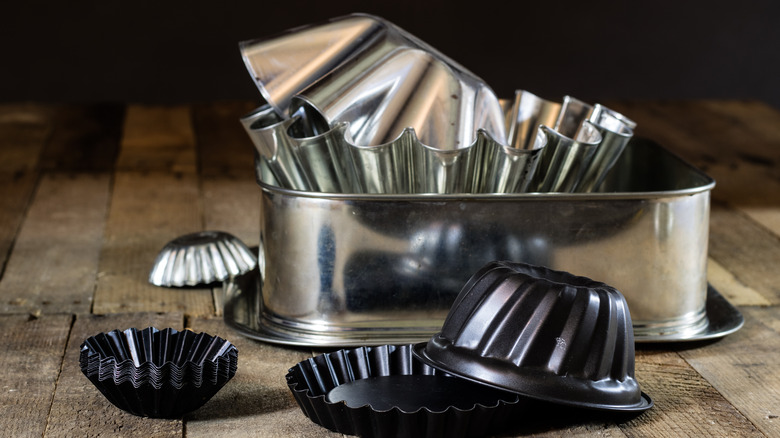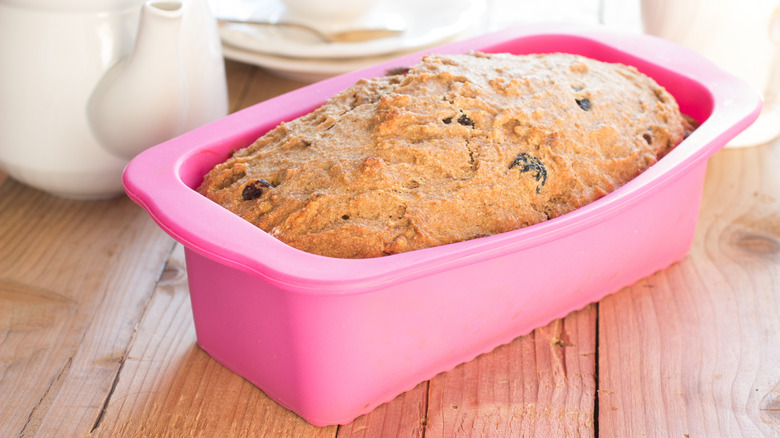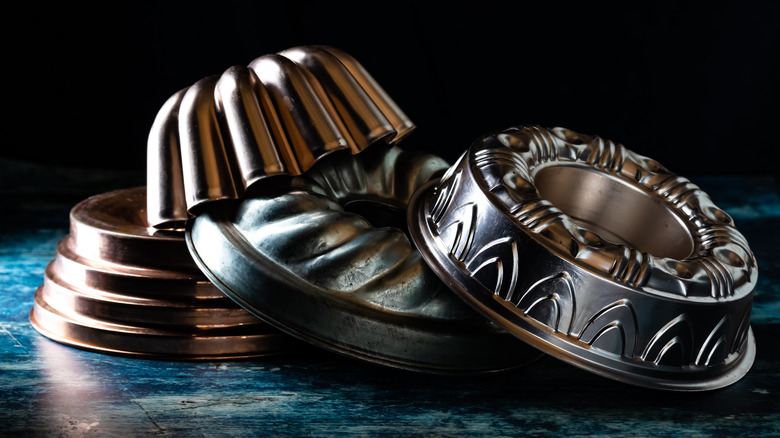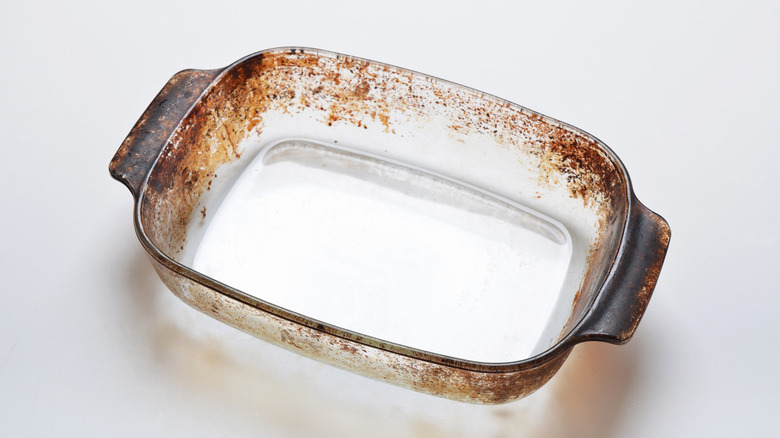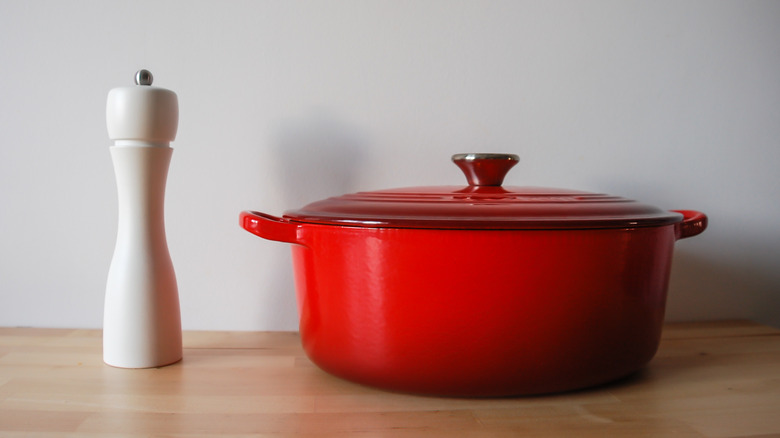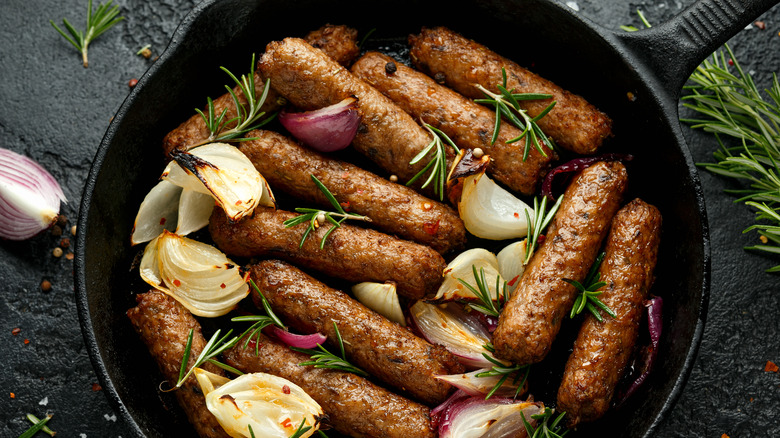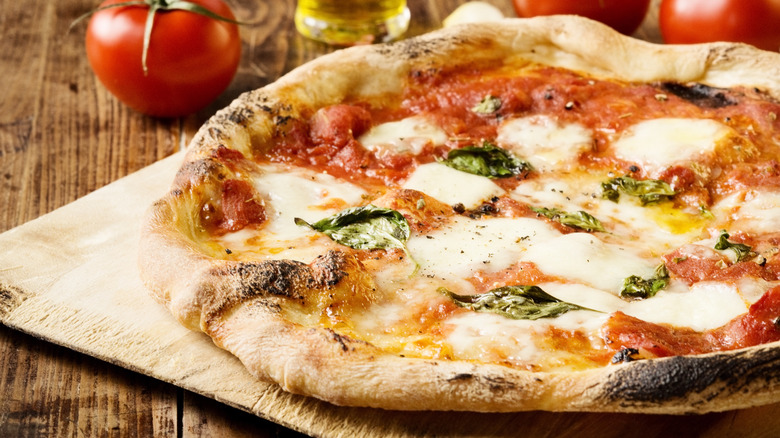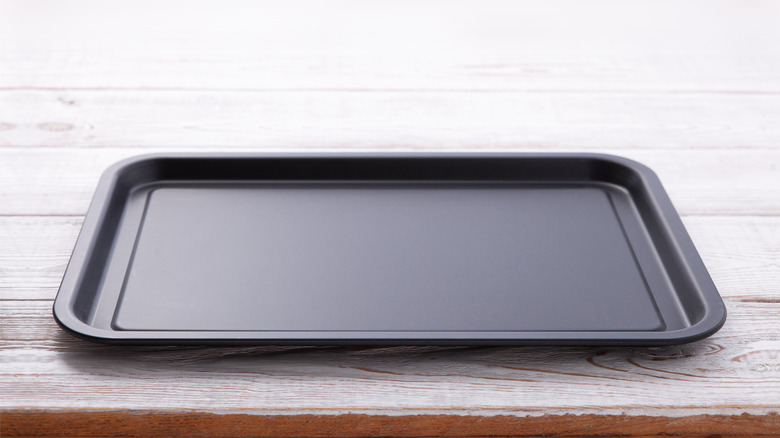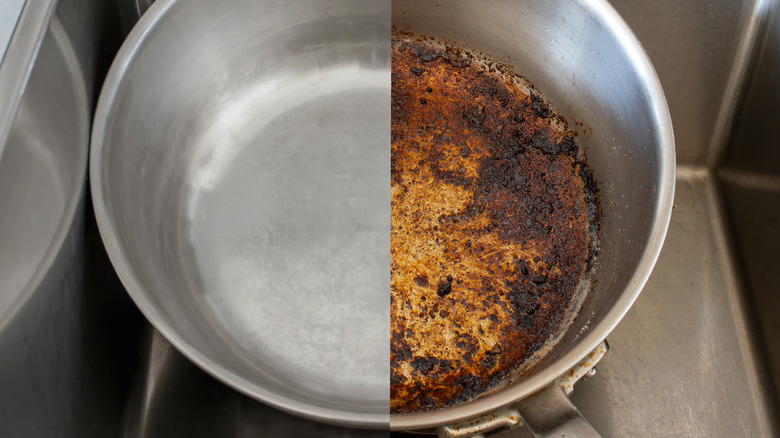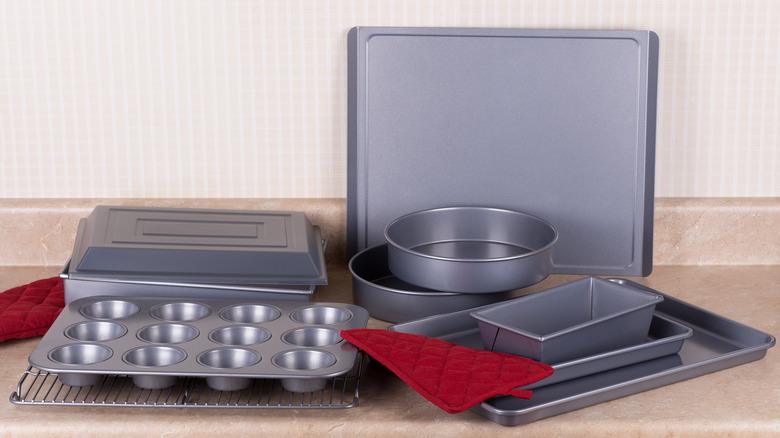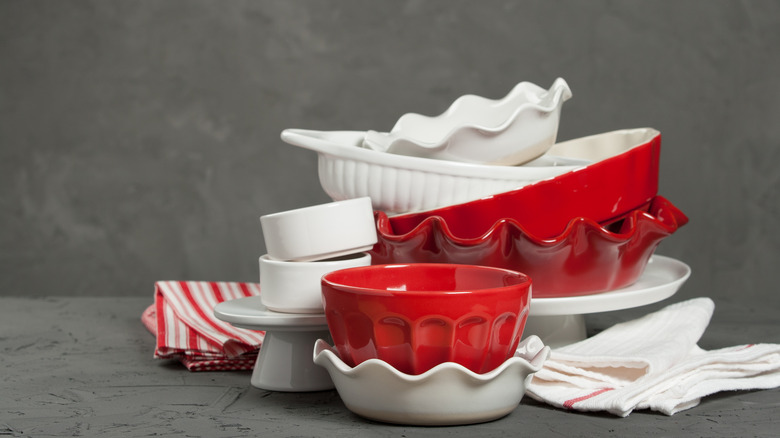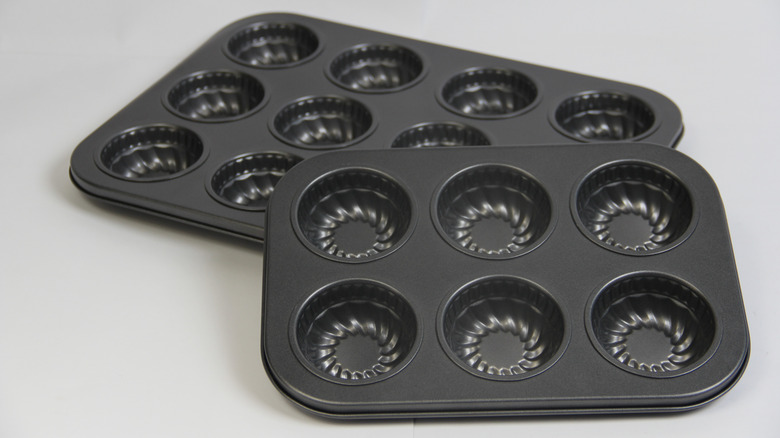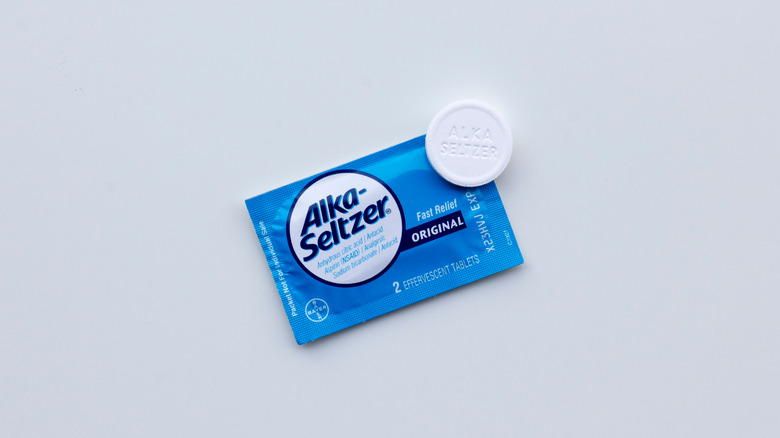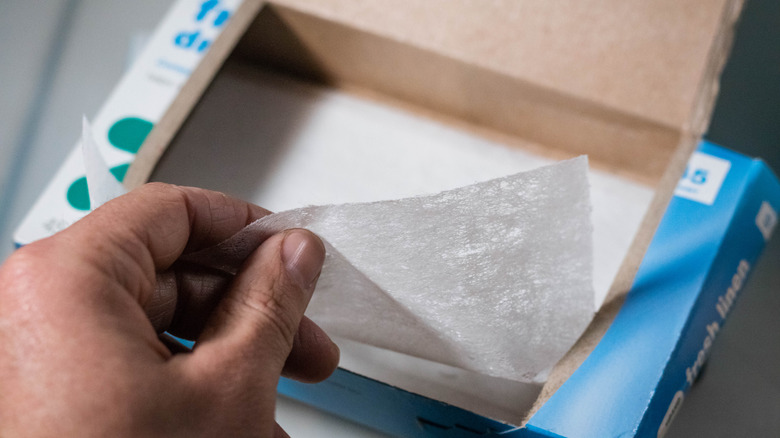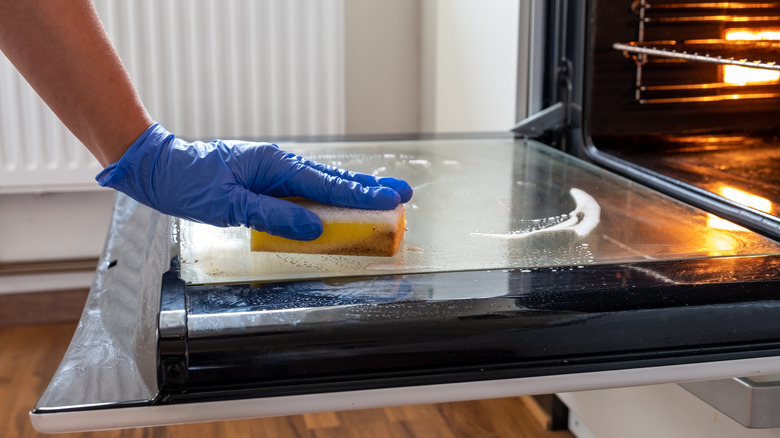Here's How To Properly Remove Those Pesky Stains From Your Bakeware
Cooking up a storm in the kitchen is one of life's greatest pleasures, but the cleanup after preparing a tasty masterpiece? Not so much. We've all been guilty of taking shortcuts when it comes to cleaning pots and dishes, but in the long run, this can considerably reduce their lifespan. "While many [pans] technically can go in the dishwasher, you are more likely going to need to replace [them] faster," Sunipa Kreuzer from Crate and Barrel statedl in a Martha Stewart article. And when we're tackling harder-to-shift stains, too much scrubbing or harsh cleaning products can damage them.
With the considerable price of quality cooking equipment (a nice five-piece bakeware set from Le Creuset, for example, can run to $255.00), the last thing we want to do is have to replace things on the regular. Luckily, cleaning off tough stains and dirt from your bakeware is simple if you know what to do. Here at House Digest, we've put together the best ways to remove pesky stains from all types of bakeware, with a few ingenious cleaning hacks, too.
Baking soda can work miracles on your silicone bakeware
Flexible silicone bakeware is an excellent choice for bakers, but while it's generally easy to clean, burnt-on food or grease can still make a mark. Fortunately, cleaning away stains is easy. "[Make] a thick paste with baking soda and water and [apply] it to the sticky spots," said Jolie Kerr, author of "My Boyfriend Barfed in My Handbag" and host of the "Ask a Clean Person" podcast to The Kitchn. "Leave the paste to dry, and then wash it away with more hot water and dish soap."
Don't be tempted to use a scourer or abrasive pad on tougher marks, as this can damage the silicone and "remove the nonstick properties of the pan," noted Judi Alexander, vice president of marketing at Casabella (via The Kitchn). If your stains won't budge, you can use hydrogen peroxide or bleach, according to The Spruce. With hydrogen peroxide, put your silicone in the sink, put peroxide all over the stain, and keep it as-is for 24 hours so it has plenty of time to soak. Bleach should be diluted (a tablespoon for each cup of water), applied, and left to work its magic for 24 hours. These methods should only be used on lighter-colored products.
To clean your Bundt pan, soak it well first
The iconic ridged shape of a Bundt pan leaves you with two things: a distinctive-looking cake and a fiddly cleanup operation, with burnt batter easily working its way into the crevices of the tin and staining it. "Add a few drops of soap and fill up the pan with lukewarm water for a good soak," Sunipa Kreuzer from Crate and Barrel told Martha Stewart. "Once all the crumbs have softened up (generally a few hours), use a soft brush or nylon sponge to scrub thoroughly and rinse. Lastly, be sure to dry well with a towel to avoid water spots."
If you have a nonstick pan, don't scrub it too heavily, and don't use a brush with hard bristles or a scourer. This can damage the pan, according to Southern Living. If your stains or burnt bits are particularly stubborn, you can include a little baking soda in the soaking solution.
When it comes to Bundt pans, it's also important to keep in mind that you shouldn't leave them too long after cooking before you wash them. Ideally, you want to soak them immediately so the residue doesn't harden and set in.
Stains on Pyrex bakeware are easily shifted by baking soda, vinegar, and even cornstarch
Pyrex bakeware items are endlessly versatile and sturdy, but the glass can discolor surprisingly quickly. Once this happens, the stains can be seemingly impossible to remove. When this happens, baking soda is your best friend, as Taste of Home noted. Pour a layer of baking soda over the bottom of your Pyrex dish, in addition to a squirt of dish soap. Pour over some hot water, and give it 15 minutes to sit and rest. Next, you'll want to take a sponge, and use it to scrub, scrub, scrub the stains off. If they're particularly difficult to remove, feel free to use more baking soda.
If you don't have baking soda on hand, you can also prepare a vinegar-water-cornstarch mixture, apply it to your stains, and scrub away, according to The Kitchn. If you're using a cleansing product, make sure it's a non-abrasive one, and opt for a nylon or plastic cleaning pad, as per the Pyrex website. Anything too heavy-duty could scratch or damage your dish.
Your Le Creuset can be cleaned by boiling the stains out
Le Creuset dishes are known for their durability, and keeping yours in good condition will extend its lifespan for years to come. To help loosen and remove burnt-on stains or leftovers, fill your Le Creuset dish with warm water, and add a good amount of baking soda, as an instructional video on the Le Creuset YouTube channel shows. Then, you'll want the mixture to reach a rolling simmer, and let it simmer for eight to 10 minutes. Once the time is up, remove your Le Creuset from the heat, allow it to cool, and then drain. Add some soap, scrub away the remaining residue with a non-metal sponge, and dry it off.
Your Le Creuset should be shining after this, but if not, specialist cast iron cleaners (such as Le Creuset's own brand) can be used, according to Cookware Insider. As a last resort, you can also use a mixture of water and bleach (1 teaspoon of bleach to 1 pint of water), and let the dish soak for a solid chunk of time before cleaning away. Bear in mind that this can damage your cookware, and you should really only turn to this method one or two times a year (if that).
Simple kosher salt can clear up your cast-iron skillet
There's nothing quite like food from a cast-iron skillet, but that restaurant-quality cooking can leave you with a tricky cleanup job. Luckily, burned-on food is easier to clean than you may think, with simple kosher salt acting as an awesome cleanser, according to Today. Pour a good amount of kosher or sea salt into the pan, and use a damp sponge or washcloth to get rid of the food. You can also work the stains with a plastic pan scraper if they're particularly difficult to remove. Just avoid using scourers or steel wool, as these can strip off the seasoning on your pan and cause damage beyond simple staining.
Cast-iron skillets are also particularly susceptible to rust damage. If this happens, there's no need to throw it out. Take some warm, soapy water and some steel wool (This is when you can use it!) and scour the pan thoroughly, according to Lodge Cast Iron. Then, wipe a light layer of oil all over the skillet, and then bake the pan for around an hour at 450 to 500 F. This will re-season the pan, leaving it good to use once more.
Learn to embrace your pizza stone's stains
For top-quality pizza, a pizza stone is a home cook's best friend, but they can be a little confusing to clean. In reality, though, most of the time all you need is a little bit of water to clean your stone, as Giordano's pointed out on their blog. Simply wet the surface with a bit of hot water and, taking a stone brush, get scrubbing. Wipe the pizza stone with a cloth, and leave it to dry fully.
For stain removal, it's a little more involved. You'll want to scrape away any leftover food particles with your stone brush or a spatula, then apply a simple paste that's made up of equal amounts baking soda and water to any stains. Take your brush, and scrub the paste very well. When the stain lifts, use a moist cloth to wipe away the mixture. Then, let it dry.
It's worth pointing out, though, that stains on a pizza stone are really not a bad thing. A well-used pizza stone is a marker of "love," according to Giordano's, and over-cleaning it can remove the natural seasoning that you build up through cooking your classic pies on it.
Baking soda can help clean up nonstick pans and baking trays — just don't put them in the dishwasher
Nonstick bakeware should, by its very nature, be pretty good at keeping stains or stuck food at bay. Over time, though, nonstick surfaces can wear down, making stains more likely to occur. When tackling these, natural is best. "Mix baking soda with water or olive oil until it reaches the consistency of toothpaste. This works great as a green cleaning option and even works to remove burnt-on grease," Leslie Reichert, a cleaning coach and author of "The Joy of Green Cleaning" told Cooking Light.
According to Reichert, nonstick pans and bakeware become harder to clean the longer you leave them before washing up, so prevention is key by cleaning them as soon as possible after using them. Using abrasive pads to clean this cookware is inadvisable, as it scrapes off the nonstick layer. Furthermore, it's best to forego sticking your nonstick pan in the dishwasher. "Even if your nonstick pan says 'dishwasher-safe,' hot temperatures and harsh detergents will break down the surface," Reichert noted. Instead, stick to washing them by hand, to keep them in good health.
Baking soda works wonders with stainless steel bakeware
Stainless steel bakeware can scorch quickly, and tending to stains correctly is vital. Cleaning a still-warm pan is much easier than tackling it cold, so get to the job ASAP, as the NY Times suggested. For tougher stains, make a paste of baking soda and water, and put it on any stains. Let the paste to sit for several minutes, and then brush it off with a scouring pad. If this doesn't shift the grime, try bringing a solution of baking soda and water to a boil in the pan, allow it to cool down a bit, and then brush off the dirt.
For years-old stains, place your entire pan in a large pot filled with a solution of baking soda and water. Bring it to a simmer, let it cool, and then brush away the stains. Rubbing it with baking soda can also restore its beautiful shine, according to The Spruce. Just avoid using oven cleaner to clean it. "The idea behind using oven cleaner on pans is basically that it's very good at removing burnt-on food ... but the problem is that it can remove coatings," says Jolie Kerr, cleaning expert and host of the podcast "Ask a Clean Person" (via NY Times).
Use a hydrogen peroxide and baking soda combo for your aluminum bakeware
Low-cost and long-lasting, aluminum bakeware is a winner — that is, until cooked-in stains leave it looking unsightly. For the hardest-to-shift dirt, using a combination of hydrogen peroxide and baking soda can thoroughly clean up your bakeware, according to an article from The Kitchn, which compared five different methods of cleaning aluminum pans. Pour a generous amount of baking soda on your pan, and then add the hydrogen peroxide on top. Leave the mixture as-is through the night. The next morning, you'll want to remove the mixture, and scrub the bakeware with warm water and soap.
For less hardcore stains, mixing up cream of tartar with vinegar, and leaving the mixture on stains for eight hours can help to get things looking brand new. Instead of leaving things to soak, you can also hasten the stain removal process by bringing a solution of water and a cleaning solution (white vinegar, cream of tartar, or lemon juice) to a boil, according to Bob Vila. Add 2 tablespoons of cleaning product per 1 quart of water, simmer for 15 minutes to loosen up those stains, pour the mixture out, and then delicately scrub the pan.
Cleaning stone bakeware will differ, depending on whether it's glazed or unglazed
For that farmhouse feel, stone bakeware is just the ticket, but once it stains, it's pretty hard to get it looking brand new again. It also depends on the type of stone bakeware you have, as unglazed and glazed stoneware have different methods of cleaning, according to Pampered Chef. Unglazed stoneware will develop "natural nonstick" coating (known as seasoning) over time with use, so staining is natural, and cleaning too vigorously is detrimental. For burnt-on food, simply wash it with warm water and a pan scraper. Alternatively, create a paste of water and baking soda, apply and leave it for 10 to 15 minutes after removing as much burnt-on grime as you can, and then scrape it off.
Glazed stoneware can take slightly more rigorous washing. As well as using the same baking soda method, a ceramic cleaner can help to clear milder stains, according to Lodge Cast Iron. Deeper stains can take a little more work and will benefit from soaking your stone bakeware in a solution of bleach and water for a few hours, after cleaning it with a ceramic cleaner.
Using bleach on anodized bakeware will shift stains, but check your product guidelines first
Anodized cookware is praised for its durability, due to the oxidizing process that makes it more impervious to damage, as The Spruce Eats explained. Unfortunately, it can still stain pretty badly. When this occurs, most marks can be removed with a simple paste of baking soda and water, according to SFGATE. Rub the paste into your bakeware using a nylon scrub pad, and then let it sit for around 30 minutes or so. Then, wash away the stains using soap and water.
If that doesn't budge the stains, using bleach or bleach-based products on anodized bakeware could also do the trick, depending on your manufacturer's instructions — just make sure to check the guidelines for your specific product first. If you're finding that your cookware is looking a little dull after multiple uses, specialist hard-anodized cleaners can help to renew their shine (via SFGATE). Just make sure that you never scrub your anodized bakeware with steel wool or other heavy-duty scouring products, as they can cause damage.
For particularly stubborn stains, dig out a box of Alka-Seltzer
If you're in a pinch with an incredibly pesky stain, and you're finding your cupboards empty of lemon juice, vinegar, or other classic cleaning products, what are you to do? Well, if you have Alka-Seltzer on hand, you are in luck.
Using Alka-Seltzer is a surprisingly effective way to get your pans clean in just about no time at all. This is largely due to Alka-Seltzer's composition: The tablets contain citric acid and sodium bicarbonate (or baking soda), according to the Alka Seltzer website, both of which can cut through stains fast.
For stained bakeware, simply fill up your dish up with hot water, and add up to six Alka-Seltzer tablets, as The Spruce stated. Then, leave it for an hour, and you should be able to scrub away the grime easily using detergent, hot water, and a regular scrubber.
Your laundry cleaning products could be super effective for getting pesky stains off bakeware
With the power they have to leave your clothes clean and fresh, it's perhaps little surprise that fabric softener and dryer sheets can work wonders on stained bakeware. If your casserole dish is looking a little grubby, squirt in some fabric softener, and then mix and fill with water, according to Reader's Digest. After leaving it for an hour, your stains should be sufficiently loosened up and easy to wipe away.
Dryer sheets can work wonders on all manner of bakeware, most likely due to the conditioning ingredients that come in the sheets soaking into the dirt, Donna Smallin Kuper, author of "Cleaning Plain & Simple" revealed to Today. Simply fill any stained bakeware with warm water, and add a dryer sheet onto the water's surface. Stains will start to be lifted even by leaving it for 15 minutes or so, although for harder-to-shift dirt, you can leave the pan to sit overnight. Pour the water away, and dispose of the sheet, and then wipe away the stains with a soft sponge.
Using oven cleaner can be effective on your pans, but it's a heavy-duty option — so be careful
When nothing else will shift your stains, oven cleaner may very well do the trick. As products that are designed to remove years of baked-in dirt from your oven, they can work wonders on bakeware, particularly for glass products or Pyrex dishes, according to Apartment Therapy. Spray some oven cleaner onto your stained cookware — making sure to put on gloves before you start — and place it in a sturdy trash bag. Seal well, and let it sit overnight. Then, remove the bakeware from the bag outside in a well-ventilated area — making sure not to inhale any fumes — and then wash your dish.
The reason for all this caution is because while oven cleaner is very effective for cleaning off stains, they often contain chemicals that can be seriously damaging to health, according to Ovenu. The corrosive alkalis that are often present in oven cleaners can seriously irritate the skin, and inhaling the fumes can lead to difficulty breathing and/or damage to the airways, as Mount Sinai stated. More profound oven cleaner poisoning can result in severe long-term damage.
